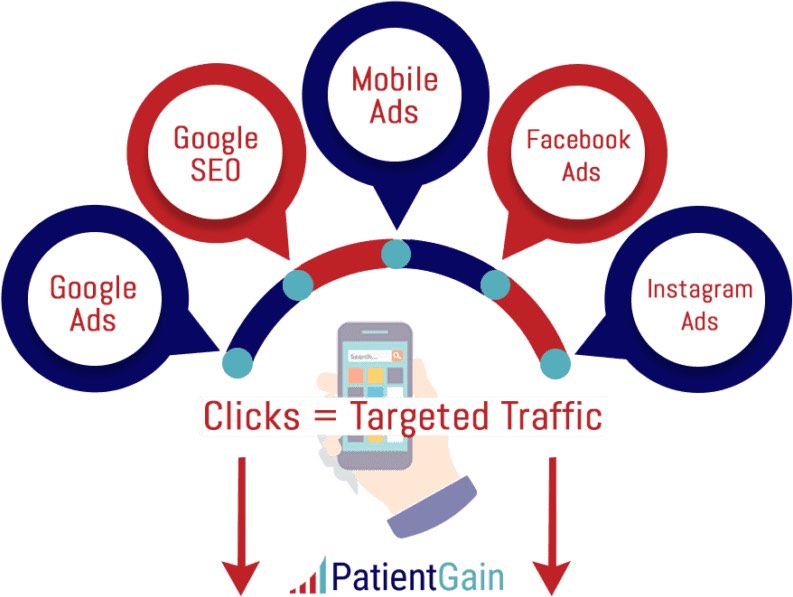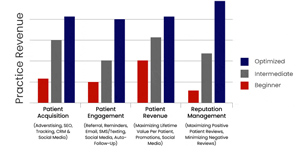How to Increase Patient Flow in Medical Practice: Start with your medical practice website
To increase patient flow in a medical practice, focus on streamlining processes, optimizing scheduling, and enhancing communication. This can be achieved through implementing technology, improving staff training, and optimizing clinic layout.
Examples of how website often serves as the central hub for new patient acquisition for medical practices. A medical practice’s website is far more than just an online brochure; in today’s digital age, it’s the central hub for new patient acquisition. It’s the digital front door where potential patients often make their first contact, gather critical information, and take the initial steps toward becoming an actual patient. A well-crafted website is the cornerstone of any medical practice’s growth strategy. It acts as the primary destination where all marketing efforts—from paid ads to social media and email—converge. PatientGain.com’s Platinum Service elevates this central role by providing a fully integrated, HIPAA-compliant, and conversion-optimized website platform designed specifically for healthcare providers.



Examples of how a medical practice’s website serves as this crucial hub:
- Information Resource & Service Showcase Leading to Call To Action (CTA):
- Detailed Service Pages: A prospective patient searching for “knee replacement surgery in [City Name]” might land on a detailed service page on an orthopedic practice’s website. This page provides comprehensive information about the procedure, the surgeons’ expertise, benefits, and recovery. CTA: Integrated “Request a Consultation” forms or prominent phone numbers on this page allow the interested individual to immediately take the next step.
- Physician Bios: Patients often want to know about their potential doctor. Comprehensive physician bio pages with qualifications, specialties, philosophies of care, and even introductory videos build trust. CTA: A “Book an Appointment with Dr. Smith” button directly on their bio page converts interest into an appointment.
- Insurance Information: Clearly listing accepted insurance plans (or information about self-pay options) is crucial. CTA: After confirming their insurance is accepted, a visitor is more likely to use an online appointment scheduler or call the practice.
- Patient Testimonials & Case Studies: Showcasing successful patient outcomes and positive reviews directly on the website builds credibility. CTA: After reading positive experiences, a visitor might be encouraged to fill out a “Contact Us” form for more information about how the practice can help their specific condition.
- Direct Lead Generation & Conversion Point:
- Online Appointment Scheduling: Many modern medical websites integrate HIPAA-compliant online scheduling tools (like those PatientGain.com might offer). CTA: Patients can view available slots for specific doctors or services and book their appointments directly on the website, 24/7, without needing to call. This is a direct conversion.
- New Patient Registration Forms: Practices can offer downloadable or online new patient forms. CTA: While not always a direct acquisition for a new patient, making this process easy for those referred or already deciding can streamline their onboarding and solidify their choice. Sometimes, submitting these forms is the first step for a new lead.
- Contact Forms/Inquiry Forms: For specific questions or service inquiries, “Contact Us” or “Ask a Question” forms are essential. CTA: Each submission is a new lead captured directly by the website, often fed into a CRM for follow-up.
- Click-to-Call Buttons: Especially on mobile versions of the website, prominent click-to-call buttons allow users to instantly connect with the practice. CTA: This drives immediate phone inquiries, which are a primary way new patients initiate contact.
- Landing Destination for All Off-Site Marketing Efforts:
- Paid Advertising (Google Ads, Social Media Ads): A Google Ad for “urgent care [City Name]” or a Facebook ad promoting “discounted dental check-ups” will almost always direct users to a specific landing page on the practice’s website. CTA: This targeted landing page is optimized with relevant information and a clear call-to-action (e.g., “Book Your Urgent Care Slot Now,” “Claim Your Dental Discount”) to convert the ad click into a patient.
- Social Media Profiles: The practice’s Facebook, Instagram, or LinkedIn profiles will feature a link to their website in the bio. Posts about new services, health tips, or doctor introductions will encourage followers to visit the website for more details or to book.
- Email Marketing Campaigns: Newsletters or promotional emails sent to a subscriber list will contain links driving recipients back to the website—perhaps to a blog post, a service page, or an appointment booking page.
- Online Directories (Google Business Profile, Yelp, Healthgrades): These profiles contain a link to the practice’s website. Patients finding a practice on these directories will often click through to the website to get more in-depth information before making contact.
- QR Codes on Print Materials: Brochures, flyers, or even business cards can feature QR codes that, when scanned, take the user directly to a relevant page on the website.
- Platform for Content Marketing that Attracts and Converts:
- Blog Posts & Articles: Publishing informative blog posts on common health concerns, new treatments, or preventative care helps attract organic search traffic (SEO). For example, a blog post on “Early Signs of Diabetes” might attract someone searching for that information. CTA: Within or at the end of the blog post, a CTA can encourage readers to “Schedule a Screening” or “Consult with Our Endocrinologist,” linking to the relevant service or appointment page.
- Downloadable Guides/eBooks (Lead Magnets): Offering a free guide (e.g., “Your Guide to a Healthy Pregnancy” from an OB-GYN practice) in exchange for an email address. CTA: The website hosts the landing page for this offer, captures the lead’s information, and then delivers the guide, initiating a relationship and potential nurture sequence.
- Video Content: Embedding videos on service pages (e.g., a surgeon explaining a procedure) or in a dedicated video gallery can engage visitors and build trust. CTA: The video can end with a CTA to visit a specific page on the website or call to book.
- Integration with Communication Tools:
- Live Chat/Chatbots: Many websites now feature HIPAA-compliant live chat or AI-powered chatbots (as offered by services like PatientGain.com). CTA: Potential patients can get immediate answers to simple questions, be guided to relevant information on the site, or even initiate an appointment request directly through the chat interface, all hosted on the website.
- Secure Patient Portals: While often used by existing patients, the portal login is on the main website. New patients might be directed to create an account via the website after their first contact.
To increase patient flow in a medical practice, focus on streamlining processes, optimizing scheduling, and improving communication.Implement online scheduling, utilize electronic health records (EHRs), and ensure efficient check-in/check-out procedures. Regular staff training, data analysis, and continuous improvement efforts are also crucial.
How PatientGain.com’s Platinum Service enhances your patient acquisition strategy:
A well-crafted website is the cornerstone of any medical practice’s growth strategy. It acts as the primary destination where all marketing efforts—from paid ads to social media and email—converge. PatientGain.com’s Platinum Service elevates this central role by providing a fully integrated, HIPAA-compliant, and conversion-optimized website platform designed specifically for healthcare providers.
1. Seamless Online Contact page
PatientGain’s Platinum Service includes a secure, HIPAA-compliant web page that offers multiple ways to start the patient contact with the practice. We have found that if patients are provided “options” on how they want to contact your practice. Forcing them to book an appointment results in lower conversions. However offer them multiple ways to contact you increased the conversion. However, online scheduling system embedded directly into your website is highly recommended. Patients can browse services and book appointments instantly.
Example:
A patient visits a dermatology clinic’s PatientGain-powered site after seeing a Google Ad. With one click on the “CONTACT” button, they select a convenient appointment slot, receiving confirmation immediately. This seamless flow significantly increases booked visits compared to phone-only systems.
2. SEO-Optimized, Dedicated Service Pages
PatientGain builds SEO-rich, mobile-friendly pages tailored to specific treatments or specialties. These pages attract highly targeted organic traffic and include clear calls-to-action directing visitors to schedule or inquire.
Example:
An orthopedic practice’s Platinum Service website features a “Joint Replacement” page optimized for local searches. Visitors searching “joint replacement surgery near me” find the page, read educational content, and easily submit a consultation request via a tracked form.
3. Lead Capture and Automated Follow-Up
Every form submission on a PatientGain Platinum website is captured securely and fed into the integrated CRM. Automated email and SMS follow-ups are triggered to nurture leads, converting them into confirmed appointments.
Example:
A visitor downloads a free weight loss guide via the practice website’s lead capture form. PatientGain’s system then sends personalized messages with additional information and links to schedule a consultation, increasing conversion rates without extra staff effort.
4. Live Chat and Chatbot Integration
PatientGain’s Platinum Service websites include HIPAA-compliant chatbots and live chat features, engaging visitors in real-time to answer questions or book appointments—even outside office hours.
Example:
An urgent care website powered by PatientGain uses a chatbot that proactively asks visitors if they need same-day care, capturing contact details or booking requests instantly, minimizing lost leads.
5. Prominent Testimonials and Review Management
PatientGain integrates reputation management app on the website, showcasing positive patient reviews and testimonials that build trust and encourage visitors to take the next step.
Example:
A dental practice displays 5-star reviews dynamically on its homepage and service pages, powered by PatientGain’s review app, which helps convert hesitant visitors into patients.
6. Mobile-First Design with Click-to-Call
The Platinum Service ensures the entire website is mobile-optimized. Clear click-to-call buttons appear on every page, making it effortless for smartphone users to contact the practice immediately.
Example:
A busy parent searching for pediatric care clicks the phone icon on a mobile PatientGain-powered site, calling directly without needing to find contact details, speeding up patient acquisition.
7. Integrated Marketing Campaign Landing Pages
PatientGain’s platform creates custom landing pages tied to specific campaigns—whether Google Ads, social media, or email promotions—with tailored messaging and CTAs that funnel visitors toward conversion.
Example:
A seasonal flu shot campaign links ads and emails to a dedicated landing page with appointment slots and tracked booking forms, all managed within PatientGain’s dashboard, allowing the practice to monitor and optimize campaign ROI.
8. Educational Content Driving Traffic
PatientGain supports monthly fresh content updates, publishing service pages every month and health tips that improve SEO and establish the practice as a trusted authority. Embedded CTAs convert readers into patients.
Example:
A cardiology practice’s website features an article on “Managing High Blood Pressure” that ranks well on search engines, with links prompting readers to schedule heart health screenings.
9. Comprehensive Analytics and Reporting
All patient interactions on the PatientGain Platinum website—from form fills and calls to chat and bookings—feed into a single marketing dashboard. This enables practices to see exactly where new patients come from and which pages convert best.
Example:
Using this data, a practice realizes that their “Back Pain Treatment” page drives more consultations than others, allowing them to focus marketing dollars there for maximum impact.
10. Promotion of Time-Limited Offers
PatientGain’s website tools include banners and pop-ups promoting specials or free consultations, creating urgency and prompting immediate action.
Example:
A women’s health clinic advertises a “Free Annual Exam for New Patients” offer on its homepage, with clear booking instructions and tracked conversions through PatientGain’s platform.
